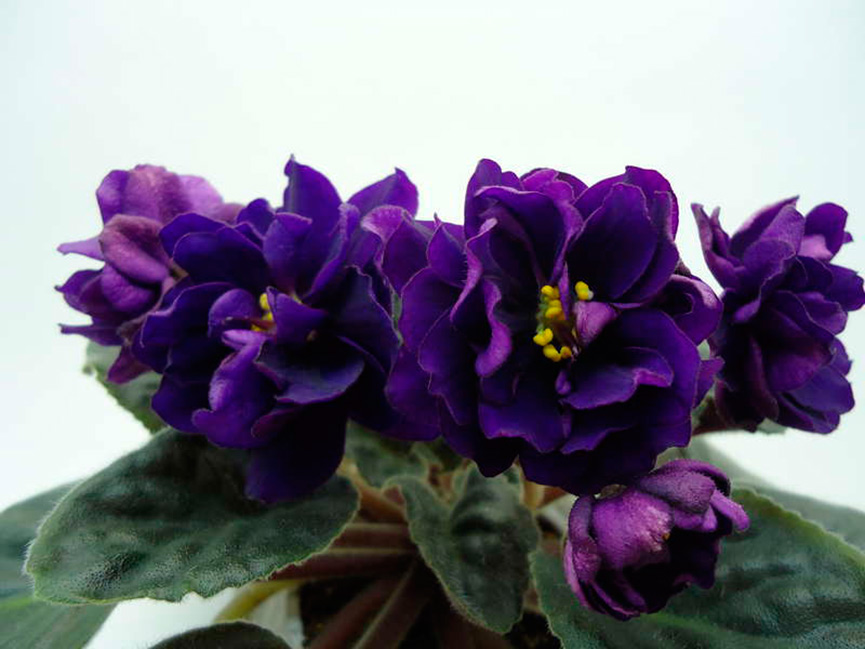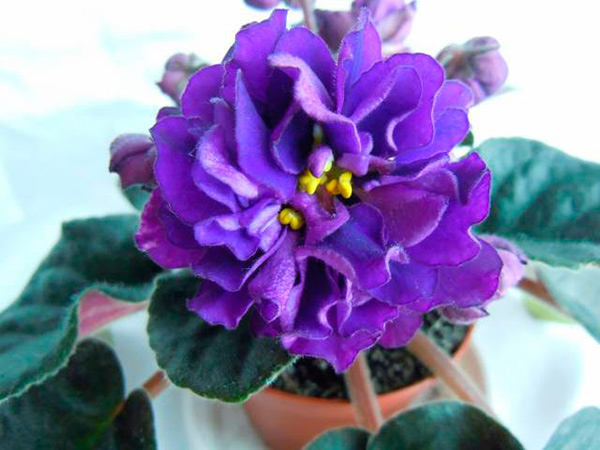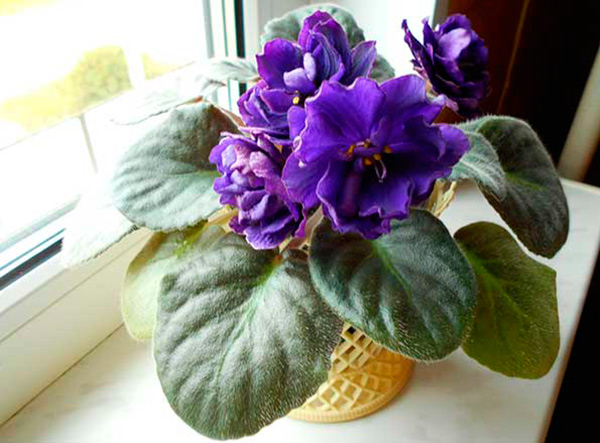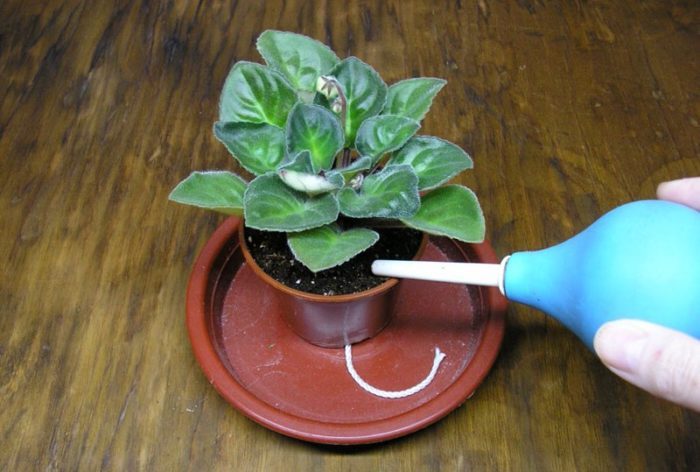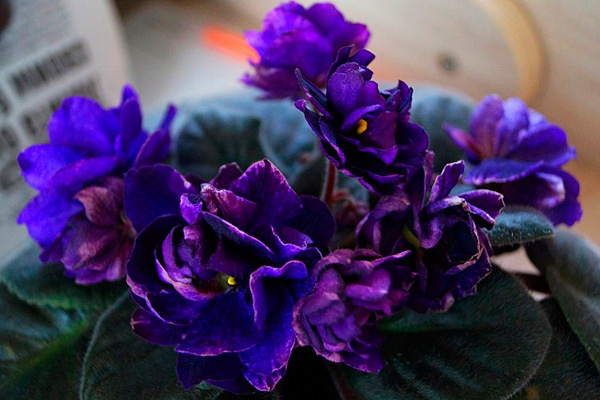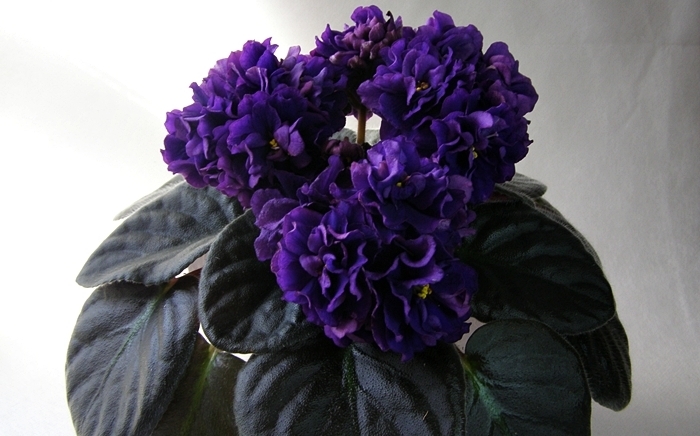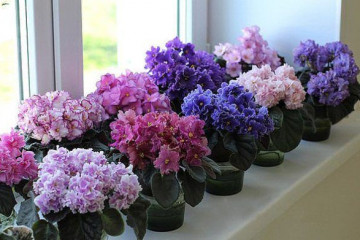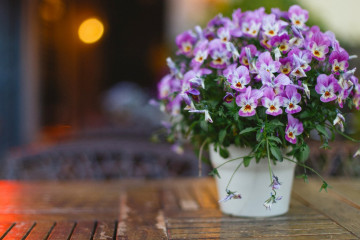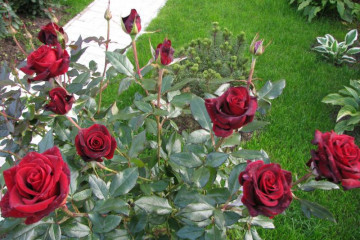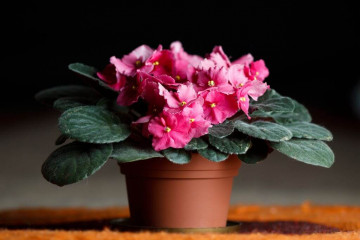Violet Black Pearl - description of a home flower
Content:
Violet Black Pearl (Fialka Black) is suitable for both experienced flower growers and beginners. Among other varieties, it stands out for its beautiful flowers and undemanding care. Thanks to its rich purple hue and long-lasting bloom, it will be able to decorate any interior.
Detailed description of violets
The leaves are dark green, both on the upper and lower sides, soft velvety on top. The flowers are very large, about 7 cm in diameter. During the flowering period, they form a charming inflorescence-cap. The Black Pearl variety is distinguished by its double flowers and huge size, purple color with a beautiful velvety tint. At the same time, 6-8 corollas are formed and bloomed in the bush. Beautiful leaves are superbly complemented by dense colorful pompoms of flowers. If you follow all the rules of care, the flowering of the violet can be extended for quite a long time.
Features of home care
For good growth and beautiful flowering, violets need timely and proper care.
Temperature
It is very important to observe the required air temperature when growing a flower. For ideal content, no higher than 20-24 ° C is suitable. If the air in the room is below 20 ° C, then the plant will not bloom so abundantly and for a long time. By adhering to this mode, you can achieve long flowering and large beautiful flowers.
Lighting
In order for the violet to grow properly and bloom magnificently, it needs to choose a good location in the apartment. The Black Pearl variety needs a lot of natural light, in which the green mass builds up faster. It is best to place the violet on a windowsill facing east or west. If the flower stands on the south side, then it will need to be shaded from the active sun at noon. In case of insufficient lighting, it is necessary to organize additional lighting for the flower.
Watering
Violet Pearl loves slightly moistened soil, but it does not need to be poured heavily, otherwise the roots may rot. Water the flower only with warm water at room temperature. During watering, do not allow water to get on the leaves of the flower, since then rusty spots may appear on them. It is best to water the flower through a tray, he will take himself as much water as needed.
Humidity
The best moisture content for violets is 60-70%. If it is higher, the flower can get sick and die.
Priming
Violet EK Pearl loves light and loose soil, which will allow the roots to be well oxygenated and retain the necessary moisture.
Top dressing
During the period when the formation of outlets occurs, the violet must be fed with organic matter. When buds are formed and flowering itself, complex mineral fertilizers containing phosphorus and potassium will be needed.
When and how it blooms
With proper care, the violet can delight with its flowering almost all year round. The color of the flowers is dark purple, very rich in color. On one peduncle, as a rule, eight corollas are formed. The buds have a rounded shape, somewhat reminiscent of the dark pearl variety (Violet Pearl), bloom very slowly. During flowering, the cap of the flowers does not disintegrate and, despite its large size, remains compact. Such a pearl color will not leave anyone indifferent.
How to propagate a violet at home
Saintpaulia propagates, as a rule, by rooting a cuttings or growing from a stepson.
Rooting leaf cuttings
The rooting process of the cutting step by step:
- Cut a well-developed leaf at an acute angle.
- Sprinkle the cut with charcoal or activated charcoal and place it in a glass of water to a depth of no more than 1.5 cm.
- When small (1-2 cm) roots appear, plant the sprout in a separate pot with a suitable substrate.
- Cover the plantings with a plastic cup.
- In about 1.5-2 months, babies should appear.
- When the babies grow up to 3 cm in diameter, they are transplanted into a separate pot.
Stepping
The stepsons need to be separated from the mother's outlet using tweezers or a toothpick and planted in a suitable soil. After 1.5 months, when new sockets are formed, they must be planted in separate pots.
Transfer
For transplanting, you need to take a larger pot a couple of centimeters and replace the soil mixture in it. The transplant should be carried out together with the old earthen lump, without cutting off the roots.
Possible growing problems
Very often, growers are faced with the following problems in growing a flower.
What are leaf problems talking about?
If a gray bloom appears on the leaves, this means that the flower is infected with powdery mildew. This could be due to poor lighting, excessive moisture or lack of phosphorus in the soil. Treatment is to spray the leaves with special preparations containing copper.
Pests
The most common pests that affect violets are:
- ticks;
- thrips;
- shield;
- aphid;
- wood lice;
- nematodes.
Common diseases
In case of violation of agrotechnical rules, such diseases may appear:
- powdery mildew. Can be seen by the white bloom on the leaves. It can be cured with foundation or bentlan;
- late blight. It manifests itself in the appearance of brown spots on the leaves. Is not amenable to treatment;
- gray rot. It appears as a brown bloom on the leaves. Leads to their fall. Treatment - spray with Bordeaux liquid.
Care errors
Often, it is due to the wrong actions of the grower that the plant begins to wither in the eye:
- if the violet is watered with cold water or placed in direct sunlight, brown spots will appear on the leaves;
- when applying a large amount of fertilizers, too dry or humid air, leaves may turn yellow;
- if the temperature of the content is too low, the leaves will acquire a pale green tint;
- with an untimely transplant or improper lighting, the violet stops blooming, and the leaves begin to grow poorly.
Violet Black Pearl is unpretentious in care, but still requires proper attention. Observing all the rules for caring for the Black Pearl violet, you can achieve abundant and beautiful flowering.
